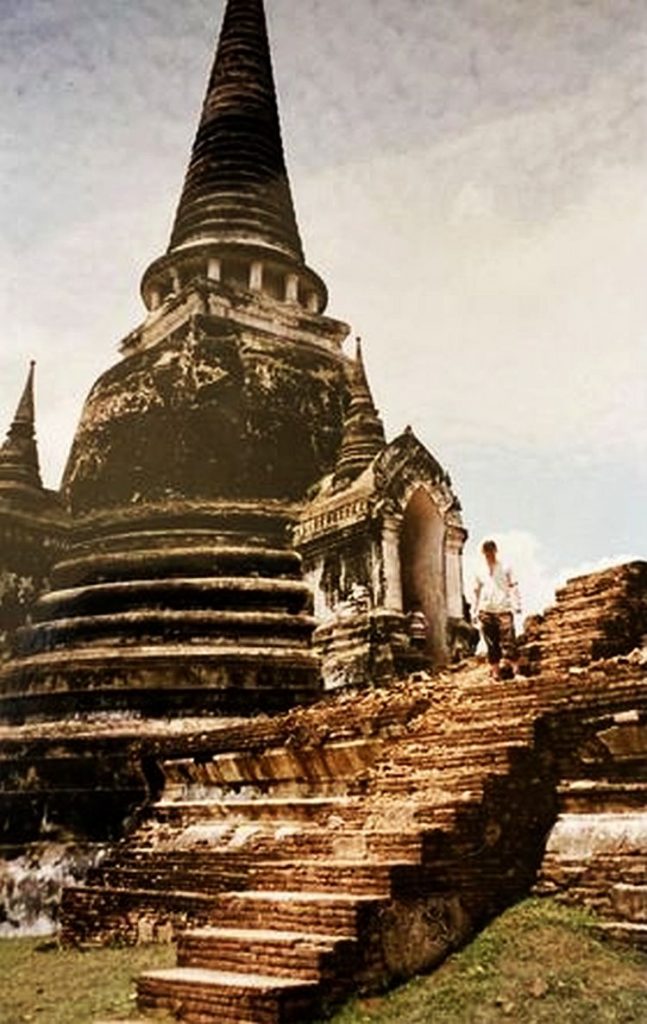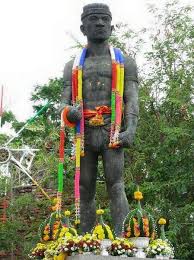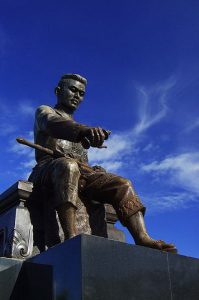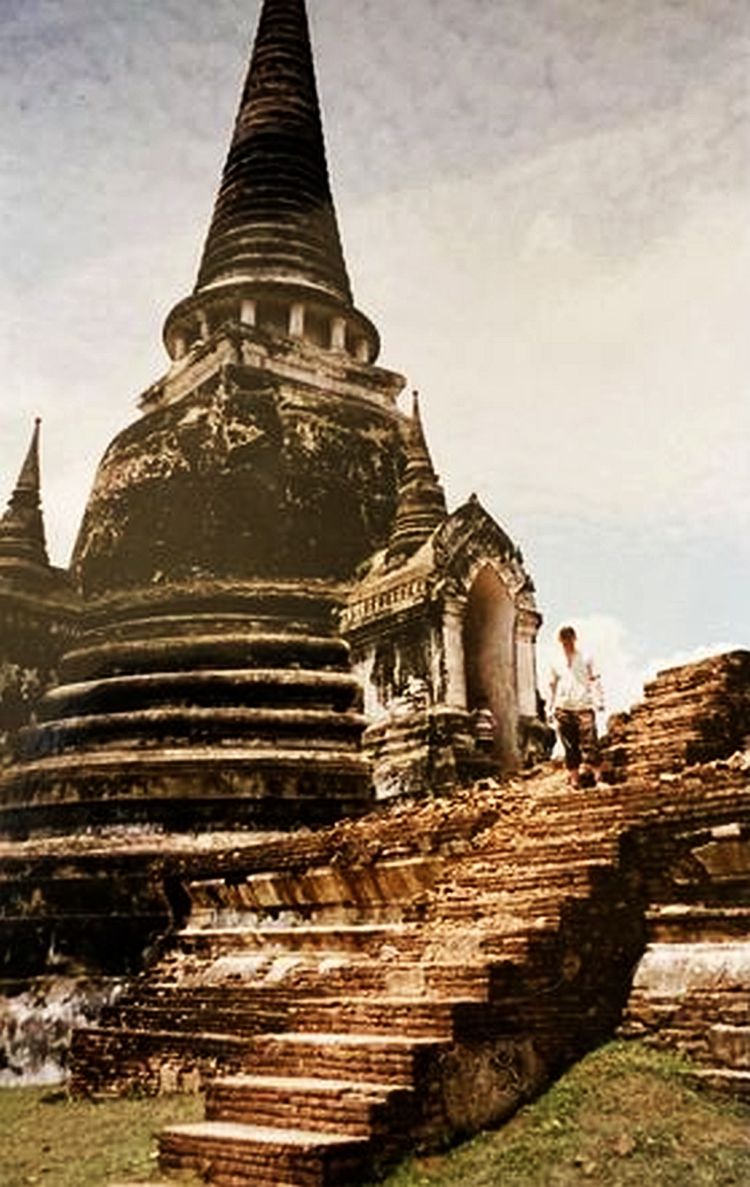
Some of the most prolific empty hand fighters in the world have come from Thailand. The training methods alone make for a well conditioned and physically fit fighting machine, offensive in approach rather than defensive. The attitude of no surrender in the ring is a legacy from their past. This attitude, having of course been shaped by Thailand’s colourful and turbulent history. A history checkered by attacks on their culture, towns and cities.
The collective unconscious of the Thai race has been fashioned and shaped by their history, which alas is incomplete.
Thailand’s early historical records were lost in 1767 when Burma laid siege to Thailand’s ancient capital Ayutthaya. The city was eventually overrun and put to the torch so all treasures, books, records, works of art and the Royal archives were all destroyed. All we are left with are the fragments of a society pieced together by anthropologists, historians and archaeologists. Pieces taken from the Burmese, Cambodian, Chinese and early European writings.

One of the most popular stories of the past comes from sources in Burma and they relate to the great fighter Nai Khanom Dhom, who having been captured by the Burmese regained his freedom by defeating 12 of Burma’s best fighters. So important was the event that stadiums around Thailand today still honour the hero by dedicating one Fight Night a year to him.
This method of settling disputes was not uncommon in Thailand and indeed the same idea was used in Europe when it came to matters of honour. In Europe it was known as a duel.
The Chiang Mai Annals relate a story of King Sen Muang Ma (1411) whose two sons Yi Kumkam and Fang Ken fought for the throne. After a lengthy battle neither could beat the other’s army, so it was suggested by Fang Ken that they fight man to man in single combat. Each side selected a champion fighter from among their army of supporters who would fight till first blood was drawn. Evidently the fight lasted several hours until Yi Kumkam won and became the new king.
In the time of King Naresuan (1590-1605) Muay Thai became part of the military training regime and it was practised from a manual known as the Chupasart. This dealt with the use of weaponry as well as the empty hands and it is likely that the modern practise of Muay Thai owes its origin to this treatise.

King Naresuan practised these arts personally and actually fought in several contests. In 1577 he was declared a national hero during the reign of Pra Chao Sua (1703-1709). During his reign and the army, having very little to do, practised Muay Thai or Dee Muay as it was commonly called. It later worked its way into the national education curriculum as Thailand went through a period of relative peace and it became a national sport.
Every village in Thailand had it’s fighters and would stage prize fights on a regular basis. Heavy gambling often led to all or nothing fight with serious injury and even death as a consequence. Pra Chao Sua himself was said to have taken part in these fights defeating many local champions.
Modern day Thai fights are no longer as brutal (as before/as they were in the past), as gloves, gum shields, protective boxes and strict rules now prevent deaths in the ring. In the age of Pra Chao Sua it was not uncommon right up to the 1920’s that boxers would bind their hands in hemp, often applying a sticky resin which hardened to make their fists like concrete. It is also believed that they wore crude groin guards of tree bark or shell for extra protection. The boxing rounds were not timed and there was no such thing as weight divisions. The fight would often continue until one man dropped to the ground.
Muay Thai was being taught in schools up until 1921 when it became prohibited due to the extent of the injuries been inflicted. However the use of hemp rope to bind the hands continued until the 30s when radical changes were made to the sport. The rules of international boxing were adapted and adopted, weight divisions were introduced, and timed rounds became the norm and modern Muay Thai, as we know it today, was born.
Elements of the traditional systems can still be seen in Thailand particularly in the practise of Krabi Krabong, a weapons system from which Muay Thai eventually developed, and in the Sila and Chaiya fighting systems of which very little is known. In fact Chaiya is only practised in its original form by a small group of individuals in Bangkok. It was taught by Archarn Thonglaw Yarlair, who if he is still alive will be in his 80’s by now. It is quite clear that the practise of Chaiya is not for sport, but is a serious and dangerous self defence system and so does not attract the numbers of students as Muay Thai would. Practitioners still practise with hands wrapped in bandages each being over 15 metres long. Traditionally these bandages were made from the winding sheets of the dead in order to scare the opponent, but this custom has been abandoned.
Training the mind plays an important role in the Chaiya fighters routine as does the physical where the adage “use 4 ounces to move 4000 pounds” is put into practise, with the emphasis being on using an opponents strength and aggression against them rather than dependence on your own brute force. With only a handful of students left, it looks as if this very important part of the Thai martial arts may die out altogether and be relegated to the history books, or transform itself into a ritual form akin to Sila, a fighting system indigenous to Thailand, which is more often than not practised as a dance.
Sila is it southern traditional folk dance particularly popular amongst the inhabitants of the three provinces of the South namely Pattani, Yala and Narathiwat. It also ranked as the most popular sport in that part of the country before the advent of Thai Boxing. Nowadays the dances are a must at all fairs and celebrations. Sila as a dance is studied and practised by all men in the southern provinces irrespective of age and class. It is regarded not only as an essential asset for men but also the key to social prestige and popularity, especially with the fairer sex. Though the movement of the dance suggests fierce fighting, the couple do not actually touch each other, this goes on for about 10 minutes then another pair will takeover and perhaps yet another, until the end of the Show.
Originally the Sila came from Menungkabao, a town on Sumatra. It was later brought to the Malay Peninsula and the three provinces in the South of Thailand where it was established as a traditional dance. Sila derives from the word seelut, which means defence, and was conceived as a system for self defence similar to Muay Thai. Later, the movements have been refined and more powerful variations introduced so that it is difficult to spot the martial arts within the dance. If you look hard enough, it is evident that this was a martial art in it’s own right. Very similar to the Malaysian Silat.
Like Muay Thai musical instruments accompany the dance including the gong, two drums and a Javanese flute. The dancers wear Malaysian style costumes comprising a short or long sleeve shirt and a pair of trousers, topped with a short sarong reaching down to just above the knees and sometimes turban-like headgear. The dance floor is just a clear space on the ground for the spectators and the dancing area a circle having enough room for the performers to dance. The dancers perform to the rhythm of music which begins slowly and gradually quickens and as in Thai boxing the performance starts with a salute to the King.
